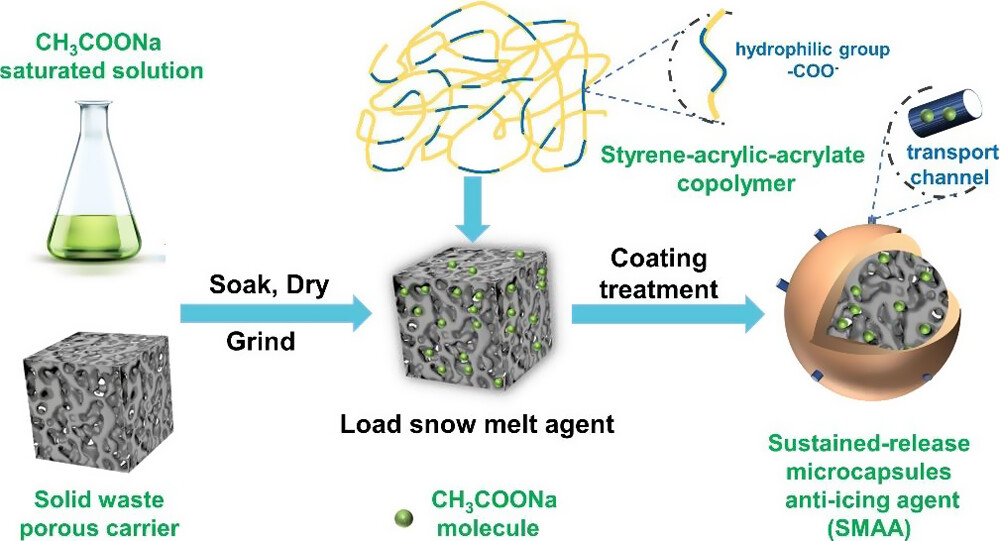Road Salt? Bah! New Roadway Material Promises A Better Solution to Snow And Ice [Hackaday]

If you’ve ever lived somewhere it gets properly cold, you’ll know that winter’s icy grasp brings the inevitable challenge of keeping roadways safe. While road salt and gritting have long been the go-to solutions, their detrimental environmental impact and the potential for infrastructure degradation are well-documented.
However, a game-changing new development might just offer a brighter, greener solution. Just imagine it—roads that stay ice free without requiring regular attention.
Rethinking Road Salt

The environmental hazards posed by chloride-based salts are significant. When these salts are washed off roads, they can contaminate nearby water sources. Furthermore, the repeated application throughout the winter months causes wear and tear on the roads and induces nasty corrosion on vehicles and infrastructure. There’s a reason cars in snowbelt regions rust so much faster, after all. And while road salt does serve its purpose of melting ice, once a fresh layer of ice forms, drivers are back in peril until salt trucks make their rounds again.
To address these concerns, many municipalities have embarked on a mission to formulate a safer alternative. Solutions include everything from byproducts from sugar beet refining or ethanol production processes. Recently, though, researchers from China’s Hebei University of Science and Technology have been working with an environmentally-friendly, chloride-free acetate-based salt. As per the research paper, not only is this salt kinder to our planet, but it’s also less corrosive, making it gentler on vehicles and infrastructure. Moreover, its efficacy in lower temperatures is a significant advantage over traditional solutions. Where traditional sodium chloride becomes ineffective as a deicing agent at around -10.9 ºC (12.3 ºF), the homemade sodium acetate solution used by researchers had a far lower freezing point of -23.5 ºC (-10.3 ºF).

Building on this breakthrough, the scientists combined the acetate-based salt with various compounds including a surfactant, silicon dioxide, sodium bicarbonate, and blast furnace slag. The idea was to allow the blast furnace slag to act as a porous carrier for the acetate salt, while the sodium bicarbonate acted as a corrosion inhibitor. The surfactant was used to increase the absorption of the porous carrier, while the silicon dioxide was used to disperse the materials more evenly. The mixed slurry was dried and crushed, with the combined powder subsequently encapsulated in a polymer solution, leading to the creation of microcapsules that could be incorporated directly into road asphalt. The concept was simple: including the microcapsules in the road surface directly would let the microcapsules slowly release their acetate salt content over time, keeping the roads ice free.
The newly developed asphalt was subsequently tested in real-world conditions on a highway off-ramp at the Sizhuang Toll Station of Beijing-Xiong’an highway.
The results of this experiment were nothing short of remarkable. The revamped asphalt not only continuously melted falling snow but also lowered the freezing point of water dramatically from -2.5 ºC (27.5 ºF) to a chilly -21 ºC (-6 ºF) on the material’s surface. In the winters of 2021 and 2022, the test section of road could be seen to outperform the neighboring regular asphalt, with almost no snow removal required in light snow conditions. In heavier snows, the snow and ice layer on the road was generally thin enough to be penetrated by regular traffic, avoiding the major loss of grip typical of a more resilient ice layer. If that wasn’t impressive enough, lab tests suggest that a slab of this innovative pavement, at just 5-cm (2-in) thick, could continuously release its stored acetate salt for an astonishing seven to eight years, ensuring roads remain clear throughout multiple winter seasons. That’s a significant improvement over previous stored-salt-release systems that exist..
As cities and countries grapple with the dual challenges of ensuring road safety and minimizing environmental impact, this new asphalt mixture might just be the solution we’ve been waiting for. The prospect of roads that can actively fend off ice for years without the need for frequent, ecologically harmful salt applications is truly a tantalizing one. Those sick of seeing their cars rot away in record time would likely also appreciate a better solution than good old sodium chloride. Watch this space, and consider petitioning your transport authorities for better ice-resistant roads in future.
Banner image: “October Snow” by Nicholas_T. Thumbnail image: “DSNY salt truck” by Chris Hamby.

![road-salt?-bah!-new-roadway-material-promises-a-better-solution-to-snow-and-ice-[hackaday]](https://i0.wp.com/upmytech.com/wp-content/uploads/2023/09/141131-road-salt-bah-new-roadway-material-promises-a-better-solution-to-snow-and-ice-hackaday.png?resize=800%2C445&ssl=1)